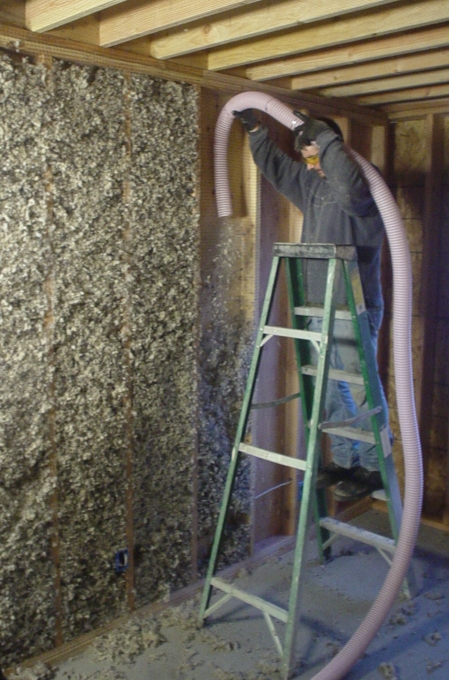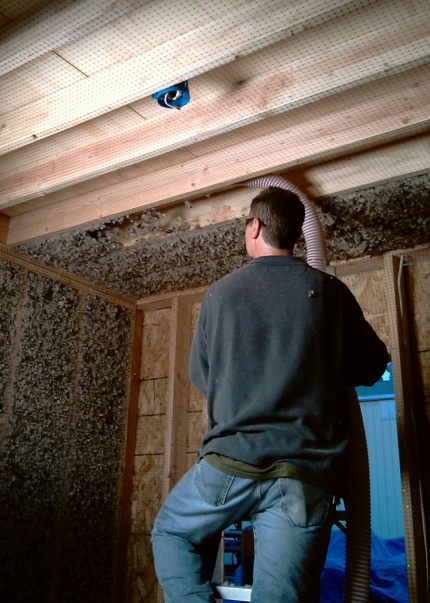I had a follow-up conversation casting doubt on the claim that 90% of wool is discarded in the U.S. (That claim hadn't been made by Oregon Shepherd, but by someone else who is hoping to introduce a wool insulation product). Bob Workman, of Oregon Shepherd, thought the figure was more like 20% waste. If I get a more definitive answer to that question I'll report it here.
Blog Post
Loose-fill Wool Insulation from Oregon Shepherd

I've been at the West Coast Green conference in San Francisco the past three days and have spend a good portion of that time checking out the trade show. One of the highlights is a loose-fill wool insulation from Oregon Shepherd.
I was surprised to learn at the conference--from a different exhibitor, actually--that 90% of the wool that is shorn off sheep in the U.S. is thrown away. Either there isn't a market for it, or there's an inability to compete with inexpensive processed wool from New Zealand. Thus, most wool is a waste agricultural product, making wool insulation an environmentally attractive commodity.
Unlike wool batt insulation products available from New Zealand, Oregon Shepherd blowing wool is 100% wool fiber; there is no added polypropylene fiber. The wool is sourced from throughout the western U.S., and wool is used that is not suitable for textile manufacturing, according to Bob Workman of the company.

Wool has inherent fire-retardant properties. At the conference here, I heard a story about a warehouse in Texas filled with burlap-wrapped bales of wool. The warehouse caught fire, burning to the ground, and the burlap burned off the bales of wool, but the wool remained unburned.
Oregon Shepherd enhances wool's inherent fire-retardant properties with a borate additive. The company uses a proprietary formulation using a natural protein to covalently bond the borate compound to the wool fibers. The material has been tested to ASTM E-84, E-1496, and C-518 standards, and passes with flying colors, according to Workman.
Along with increasing the material's fire resistance, the borate provides insect resistance--eliminating concern about moth infestations, for example.
SUPPORT INDEPENDENT SUSTAINABILITY REPORTING
BuildingGreen relies on our premium members, not on advertisers. Help make our work possible.
See membership options »
Oregon Shepherd is manufactured in the Portland area. Having shipped their first product in June, 2010, the company has been expanding by 50% per month, and is soon to move into a new 18,000 square-foot factory north of Portland. Product is being shipped nationwide in 200-pound reinforced-nylon bags.
Oregon Shepherd is installed like loose-fill fiberglass or dense-pack cellulose, using standard insulation blowing equipment. Photos here show installation using mesh, which is stapled to the inner face of studs. Though I haven't used the material, it looks as if it doesn't pack as tightly as cellulose insulation, so there may be slightly greater air flow through the material.
The insulation goes in at a density of about 1 pound per cubic foot and insulates to slightly over R-4 per inch, according to the manufacturer's literature.
As for cost, Oregon Shepard sells for $2.75 per pound. For a 2x4 wall, providing R-13 insulation will cost about $0.67 per square foot, compared with $0.35 – 0.40 for fiberglass, $0.50 to 0.55 for cellulose, and $0.85 for cotton, according to Workman.
I've looked at wool-batt insulation products, and I've always wondered why there isn't a loose-fill wool. Now there is. The product looks like a winner!
For more information:
Oregon Shepherd
Portland, Oregon
888-269-9665
See more on this product in the GreenSpec Guide
Alex Wilson is the executive editor of Environmental Building News and founder of BuildingGreen, LLC. In addition to this product-of-the week blog, he writes the weekly Energy Solutions blog. To keep up with his latest articles and musings, you can sign up for his Twitter feeds.
Published October 2, 2010 Permalink Citation
(2010, October 2). Loose-fill Wool Insulation from Oregon Shepherd. Retrieved from https://www.buildinggreen.com/blog/loose-fill-wool-insulation-oregon-shepherd
Comments
I am surprised that the cost
I am surprised that the cost is not more competitive if the wool is "waste agricultural product". Is there much energy involved to prepare it for market? The fire retardants are common to the competing products.
I have met with Italian produ
I have met with Italian producers of wool batting insulation (Bgreen through Green Metal in the US) which is rather beautiful stuff just as an object. They have one version which is treated for moths which they have an MSDS sheet on. The untreated version has been used for a long time in traditional buildings; they are selling to historic renovations in Italy. It seems too wild for the US except for the greeniest of the green but it's a useful reprurposing of waste product.
Sorry Alex, I somehow missed
Sorry Alex, I somehow missed that you had noted that.
If it actually insulates to R-4 with minimal air leakage, that would be impressive compared to cellulose, which can have virtually no air leakage, but tops out around R-3.7, I believe.
I wonder if an ASTM test for air barriers would apply here.
I had the same observation, a
I had the same observation, as noted in my blog--that it looks as if the loose-fill wool doesn't pack as tightly as cellulose and that there may be greater air leakage through it. I don't know if there's an ASTM standard for air leakage through insulation materials; if not, there should be. I'll try to find out more on this question. I would like to see how the air leakage of this material compares with that of wool batts, fiberglass batts, loose-fill fiberglass, cellulose, etc.
Thanks for sharing this produ
Thanks for sharing this product info, Alex—it's a cool introduction.
Do you have more detail not the insulation performance of the loose fill wool? From the photos, I'm wondering if it fills a space as uniformly as other loose-fill products like cellulose. In other words, it looks a little clumpy, making me wonder if there are small air cavities left in place that would reduce its performance compared with other products, even compared with wool batts, which I recall being more uniformly woven.
As we all know, insulation in
As we all know, insulation in homes and industry is the single most important option for reducing consumption of fossil fuels and thus reduce global warming. Yet far too many insulation suppliers do not provide sufficient information to do the rather complex comparisons required in order to pick the "best insulation" for the application.
I'm not a wool expert, but to be fair many U.S. sources have wool of very low quality, so can not compete New Zealand wool based on "quality" not price. Yet hard to believe wool is now a waste product! Anyway, the Oregon Shepherd website does not have sufficient technical information to assess the pros/cons. Most claims are not backed up with ASTM data and/or their claims are questionable. For example, specifically what is the data from the ASTM E84 test, and how is the wool product actually prepared for the ASTM E84 (flame spread/smoke developed) test when the test protocol requires "a nominal 24-ft long by 20-in. wide specimen" (i.e. a self-supporting sheath)? And the website refers to "breathing" and "moisture passing though" without addressing the related issues of loss of R-value. Bottom-line - - simply too many pretty words without adequate third-party testing data.




Add new comment
To post a comment, you need to register for a BuildingGreen Basic membership (free) or login to your existing profile.